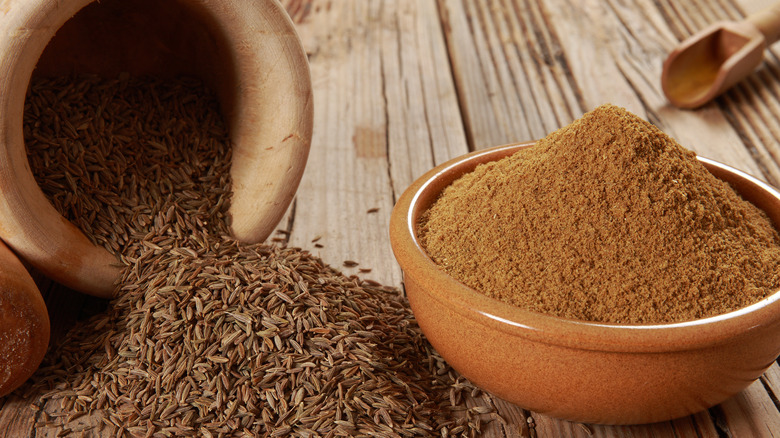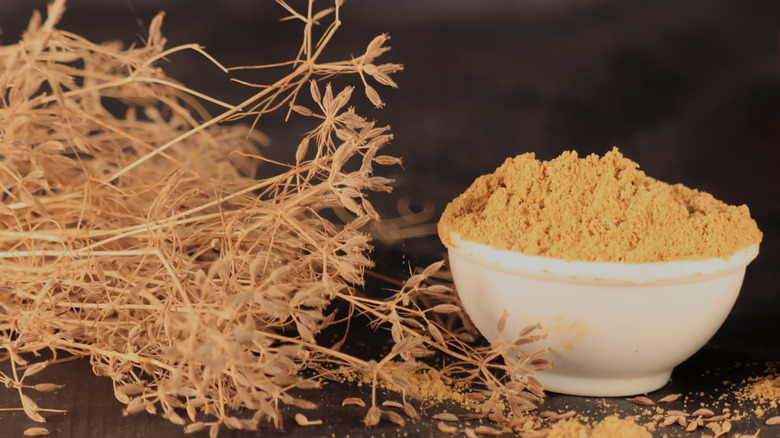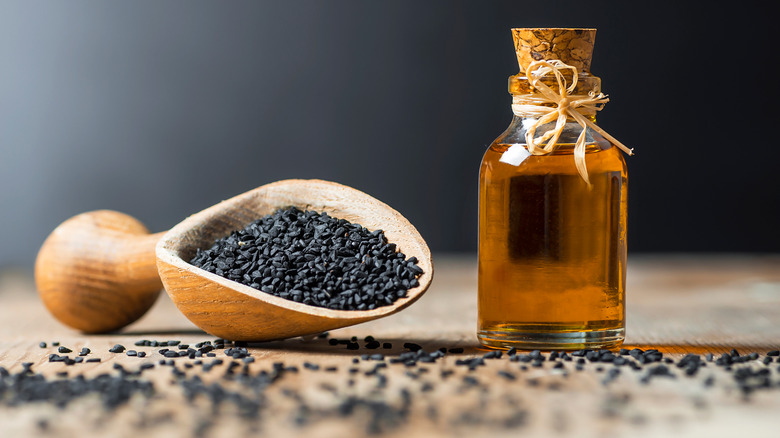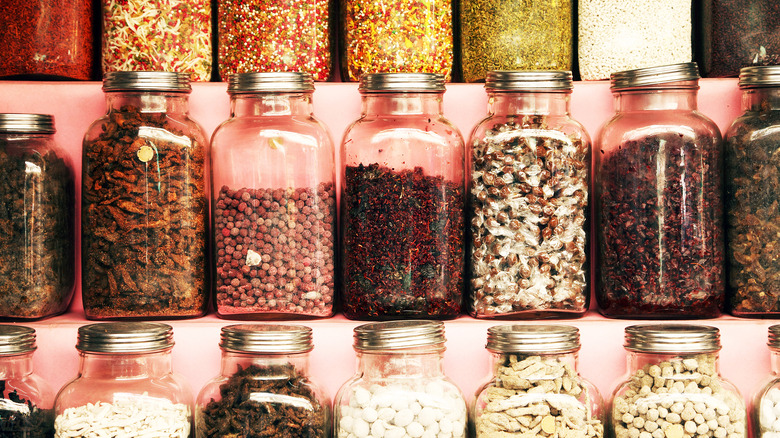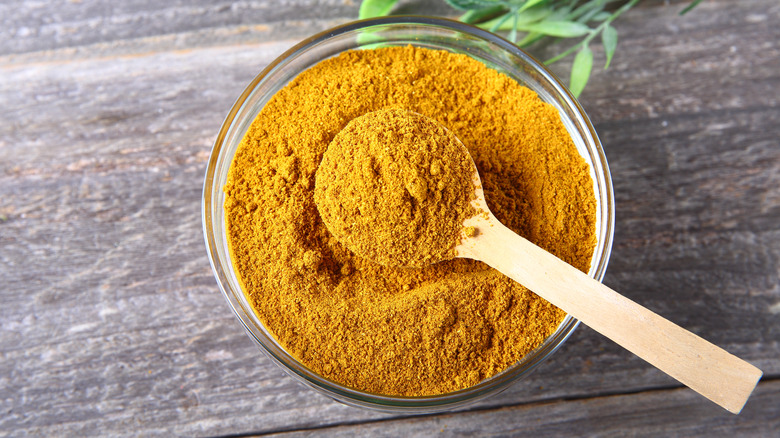What Is Cumin And How Spicy Is It?
Even if you've never personally cooked with cumin at home, you've probably tasted it in a variety of dishes, because cumin is a staple of many cuisines. According to The Spruce Eats, the spice is used across the Middle East, it's the key ingredient in countless Latin American recipes, and it's included in practically every Indian spice blend. But although cumin is widely associated with heavily spiced foods, it's only spicy by association.
Per The Epicentre, cumin on its own hardly has any heat and ranks at only three on the hotness scale. Compared to cayenne, which has a hotness of eight to nine on the same scale, cumin isn't nearly as spicy. As McCormick explains, cumin gets its intense taste and aroma not from heat, but from its unique flavor profile, describing it as "rich and hearty, earthy and warm, with an edge of citrus," and proclaiming that "cumin adds instant depth to any dish."
Where does cumin come from?
Spices that pack as much of a punch as cumin typically come from some sort of pepper, but cumin actually belongs to the parsley family. The seeds of the flowering plant are either dried whole or pulverized into a powder, becoming what we know as cumin. Though both forms of cumin are derived from the seed, Spiceography explains that they differ slightly in taste because grounding cumin seeds also activates many of its pungent compounds.
With this said, the website also notes that these compounds evaporate soon after the seeds are grounded. The result? A flavorful spice, but one somewhat lacking in the "subtler complexities." Cumin that is freshly ground, therefore, has the most intense flavor. If you are hoping to maximize the spiciness of your cumin, buying it whole and grinding it yourself is the way to go. Otherwise, cumin isn't all that spicy.
How is black cumin different from regular cumin?
You may be familiar with white pepper and black pepper, or Spanish paprika and smoked paprika, but did you know that cumin comes in different forms, too? The most common is known simply as cumin, but Home Stratosphere shares that there are four other varieties: black cumin, bitter cumin, brown cumin, and white cumin.
Black cumin, which you may have already heard of, is the type of cumin often used in Middle Eastern and Indian food, and also goes by the name nigella sativa. But black cumin, as well as brown cumin — the larger, fatter form of it — is different from regular cumin in more ways than just color. Black cumin is slightly sweeter with a more pronounced lemony flavor. White cumin, on the other hand, is warmer and stronger and has a higher oil content; and bitter cumin, as its name suggests, is on the bitter side.
How to shop for cumin
Because of how frequently used cumin is for a variety of dishes, you can easily find it in the spice aisle of practically any grocery store. The regular availability of cumin, however, doesn't necessarily mean that it's always guaranteed to be of good quality. The reason for this, according to Rumi Spice, is that cumin's flavors weaken over time. When you open the jar, there should be an intense aroma, and if there isn't, that means it's been sitting at the grocery store too long.
Distributors will often print a three-yearlong expiration date on the label, as technically that is the point of safe consumption, but cumin that's that old will be seriously lacking in flavor. Rumi Spice instead recommends buying from a retailer that is known to restock fresh spices on a regular basis, especially if you're shopping for more expensive varieties of cumin, such as black cumin or wild cumin, which are often mixed with caraway, a cheaper spice that looks deceptively similar.
How to cook with cumin
Cumin is a versatile spice, so whether you're making chutney or chorizo, the way you cook with it can significantly affect the final outcome of your dish. As Serious Eats explains, heat has a major impact on the flavors in cumin, and they vary depending on what point in the cooking process you add the spice. If you add cumin at the beginning, you'll end up with earthy, zesty flavors that are a little more subtle. Alternatively, if you add cumin toward the end, you'll get a more herbal flavor profile.
According to the website, oil also plays a significant role in bringing out the complexities of cumin. When whole cumin seeds are toasted just until fragrant in an unoiled pan over medium-high, their flavors will be more contained until ground or bit into. If the seeds are flash fried in hot oil until you hear crackling sounds, the oil itself will turn into a concentrated cumin extract that you can add more ingredients to. How your final dish tastes is all a matter of when and how you incorporate the cumin.
What are the health benefits of cumin?
If you often eat spicy food, you know that there are certain spices, typically those that are in the chili pepper family, that are known for their ability to irritate your digestive tract. Spices with strong flavors don't exactly have the best reputation in terms of being easy on the stomach, but the good news is, that doesn't apply to cumin. In fact, according to Healthline, it's quite the opposite: Cumin actually promotes digestion.
Not only is cumin naturally rich in antioxidants and high in iron, studies show that cumin promotes bile production from the liver. This in turn aids in the digestion of fats. In one study, published in the journal Middle East Journal of Digestive Diseases, 57 participating patients with IBS reported a significant decrease in symptoms not long after starting on the cumin extract treatment.
Cumin also stimulates digestive enzymes and even reduces symptoms of irritable bowel syndrome. Healthline further elaborates that when cumin interacts with the digestive system, it releases megalomicin, a chemical compound that functions as an antibiotic. This also means that cumin itself can't cause food poisoning. So if you're looking for a seasoning that won't upset your stomach but will still satisfy your taste buds with its spice level, look no further than cumin.
